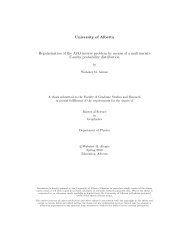Soner Bekleric Title of Thesis: Nonlinear Prediction via Volterra Ser
Soner Bekleric Title of Thesis: Nonlinear Prediction via Volterra Ser
Soner Bekleric Title of Thesis: Nonlinear Prediction via Volterra Ser
Create successful ePaper yourself
Turn your PDF publications into a flip-book with our unique Google optimized e-Paper software.
4.4. NOISE REMOVAL AND VOLTERRA SERIES 62<br />
4.4 Is Noise Removal Possible with a <strong>Volterra</strong> Se-<br />
ries?<br />
I have presented a third- order <strong>Volterra</strong> model for the prediction <strong>of</strong> seismic signals.<br />
The usual trade-<strong>of</strong>f between noise reduction and signal preservation is controlled<br />
by the length <strong>of</strong> the linear and the nonlinear prediction operators (p, q, and r). It<br />
is important to stress that waveforms that exhibit linear moveout can be predicted<br />
with a linear system. Conversely, when waveforms exhibit nonlinear moveout, which<br />
translates in the f − x domain as chirps, the nonlinear part <strong>of</strong> the <strong>Volterra</strong> system<br />
helps in modeling the signal.<br />
When I started this project, the idea was to design a new noise reduction system.<br />
The premise was to use nonlinear prediction to reconstruct signals in such a way that<br />
the reconstruction misfit could be attributed to noise. The latter is the basis <strong>of</strong> f −x<br />
deconvolution for signal-to-noise ratio enhancement. However, nonlinear filtering<br />
requires too many coefficients for the quadratic and cubic parts <strong>of</strong> the operator,<br />
therefore, signal and noise are simultaneously modeled (overfitting) (Figure 4.11).<br />
The data in the Figure 4.6(a) ) and the prediction <strong>of</strong> this data <strong>via</strong> a third-order<br />
<strong>Volterra</strong> series predicts the signal as well as the original data but noise is also<br />
fitted with the prediction. A small amount <strong>of</strong> coherent energy leaks to the noise<br />
panel. The third-order <strong>Volterra</strong> series can perfectly model the data, but for f − x<br />
noise attenuation it is not useful as it produces many coefficients and therefore<br />
models both signal and noise. The next step is to study how one can introduce<br />
regularization (smoothing) to the estimation <strong>of</strong> <strong>Volterra</strong> kernels and avoid fitting<br />
the noise.









